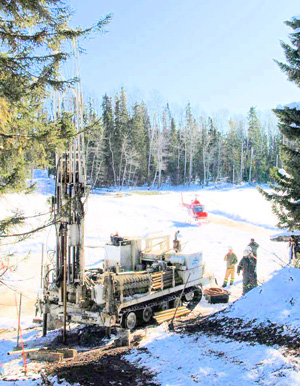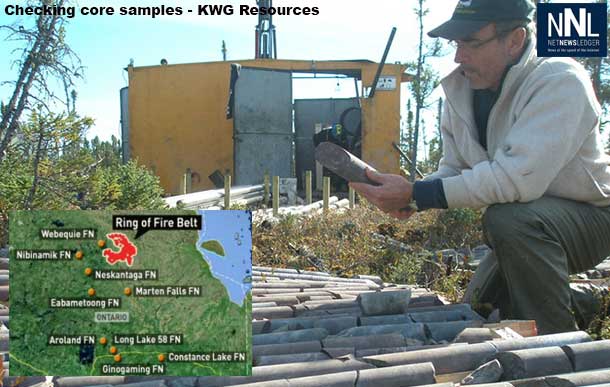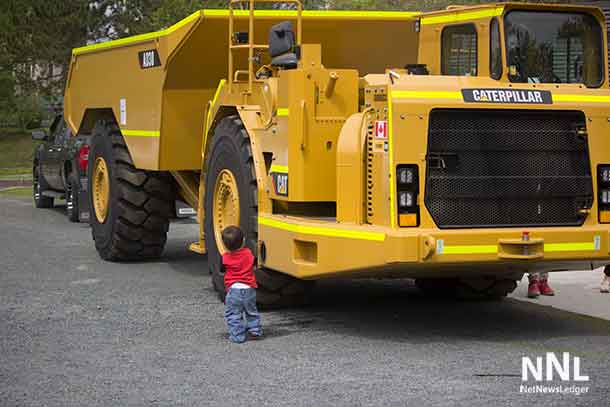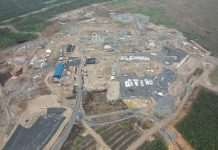 SUDBURY – MINING – Ontario’s “Ring of Fire” mineral belt, located in the province’s remote James Bay Lowlands, is thought to hold more than $60 billion of geological riches. When it was discovered in 2007, it was supposed to usher in a new era of prosperity for Northern Ontario, especially for the impoverished First Nations communities in the region.
SUDBURY – MINING – Ontario’s “Ring of Fire” mineral belt, located in the province’s remote James Bay Lowlands, is thought to hold more than $60 billion of geological riches. When it was discovered in 2007, it was supposed to usher in a new era of prosperity for Northern Ontario, especially for the impoverished First Nations communities in the region.
Almost a decade later, the ore remains in the ground and doesn’t appear to be coming out anytime soon. Thanks to the Ontario government’s ineptitude, dysfunctional mining policy, lack of promised infrastructure spending and (to a much lesser extent) a broader commodity slump, American miner Cliffs Natural Resources Inc. left the province in frustration in 2013, permanently halting its proposed US$3.3-billion chromite project.
The ultimate indignity for Ontario came last year, when Cliffs sold its US$550-million investment in the Ring of Fire to junior miner Noront Resources Ltd. — the only significant player left in the area — for a bargain-basement price of US$27.5 million.
At the present time, Noront is focused primarily on its bankable Eagles Nest nickel/copper/PGM property, valued at about $10 billion, which can be developed only if a proposed east-west road is built into the mining camp and has put its world-class chromite deposits on the backburner for the foreseeable future.
Many analysts say that Ontario missed an extraordinary opportunity to establish a chromite industry during the commodity boom, and that it will be at least five or more years before any possible development occurs.

Junior Explorer KWG Resources holds the right to earn majority control into another promising chromite deposit, which is just in the initial stage of exploration with only eight or 10 drill holes to date.
The company recently lost a two-year court battle over exclusive control of the surface rights of its claim-staked properties on the best north south transport corridor into the Ring of Fire. That strategic route, which follows a ridge of higher ground – perfect for road or rail construction – through the surrounding swampy muskeg, is now open to any company or organization with the financial ability to build any transportation infrastructure with the required government and First Nations permission.
Recent announcements of the involvement of a Chinese government state-owned rail company to potentially finance and design a railroad on KWG’s north-south claims are highly preliminary.
While the provincial Liberals shoulder most of the blame for delaying the best mineral discovery in Ontario’s mining history in over a century, they did have a legitimate complaint: the previous federal government under Stephen Harper was not at the economic table in a meaningful way.
With the election of the Trudeau Liberals, who have a strong policy mandate to alleviate the living standards of Canada’s First Nations communities, hopes for the development of the Ring of Fire and the enormous mineral potential of the entire northwestern region of Ontario has been renewed, especially with the federal government’s commitment to include significant infrastructure spending in its budget March 22.
The mining companies in the Ring of Fire need infrastructure and so do the isolated aboriginal communities. If the Trudeau government worked in conjunction with Ontario and adopted a “Marshall Plan” — the name of the American multibillion dollar initiative to help rebuild European countries after the Second World War — to develop and modernize infrastructure in the entire isolated northwest, it would kill two birds with one stone.
A recent study by the National Aboriginal Economic Development Board that focused on the territories found that “each dollar spent on Northern economic infrastructure has the potential, if invested wisely, to generate $22 in economic and fiscal benefits.”
The standard of living for First Nations communities would dramatically improve, and a new round of mineral exploration and development would take place that would generate billions of dollars in tax revenue to pay back the government’s investment. And then some.

Let’s start with the potable water crisis in northwest Ontario. Within its first 100 days in office, the Trudeau government hit a home run by announcing it would fix the water problems at Neskantaga First Nation, a community near the Ring of Fire that has been on a boil water alert for an astonishing 20 years.
However, three of the other four isolated communities in the region are also on a boil water alert, including Eabometoong, which hasn’t had potable water for 14 years. In fact, 35 of the 49 aboriginal communities in Northern Ontario had drinking water advisories in effect as of May 2015.
A 2011 report found that it would cost about $1 billion to upgrade or replace the water and wastewater needs of all these communities. As Trudeau himself would probably say, “It’s 2016.” It is high time we gave these communities the potable water that the rest of Canada takes for granted.
Another need is roads. Ontario Regional Chief Isadore Day has called for the construction of permanent roads to the many isolated First Nations communities in Northern Ontario, which would replace winter roads that are being affected by global warming. There is an old saying in the mining business that the best way to find new mineral deposits is by building roads.
The first road that should be built is an east-west corridor between the Ring of Fire and Pickle Lake, which would link up with four isolated First Nations communities. This would not only provide a cheaper way of bringing food, building supplies and diesel fuel to the communities, but would also allow Noront to proceed with development of its Eagle’s Nest nickel-copper project in the Ring of Fire.
Developing this road shouldn’t be difficult. In the early 1880s, it took Canada less than five years to build the Canadian Pacific railway from Ontario to Vancouver – a distance of roughly 4,200 kilometres. The distance between the Ring of Fire and the provincial highway system is about 280 kilometres.
However, connecting the many other First Nations communities throughout the northwest could also be done economically through the construction of forestry roads. Hartley Multamaki, vice president of Green Forest Management, said a rough estimate for primary forestry road construction, which is solid enough for huge trucks transporting logs or diesel fuel, would be around $250,000 per kilometre. The ultimate cost could be somewhat higher because of obstacles like river crossings, swamps and access to aggregates.
So, taking Multamaki’s estimate, the cost of building 1,100 kilometers of forestry road through standard Canadian Shield geography in Northwestern Ontario would be about $275 million. Add in an additional $60 million for the previously mentioned obstacles. So for $335 million, you could connect a large number of isolated communities, especially in the geologically rich greenstone belts to the west of the Ring of Fire. Not an earth-shattering sum.
The final hard infrastructure need that should be addressed is access to grid power. The vast majority of Northwestern Ontario’s isolated First Nations rely on costly diesel-generated power, which is heavily subsidized by governments. Electricity costs can run three to 10 times higher than grid power. It is also environmentally risky and limits expansion and business opportunities in these communities.
Wataynikaneyap Power is a First Nations-led transmission company that was originally started by Goldcorp Inc. five years ago to upgrade a major transmission line to their Musselwhite gold mine located 480 kms north of Thunder Bay. Twenty First Nations are participating in this advanced initiative.
The Ontario Power Authority estimates that grid connection would save roughly $1 billion over the next 30 years compared to diesel generation.
It basically pays for itself. The four communities closest to the Ring of Fire — Webequie, Nibinamik, Neskantaga and Eabametoong — could be easily connected to this initiative at an acceptable increase in cost.
The aboriginal communities in northwestern Ontario are among the most impoverished in the country and yet their territories contain billions of dollars of untapped mineral wealth. Jim Franklin, the former chief geoscientist at the Geological Survey of Canada and one of the world’s top experts on the Canadian Shield geology, predicted that at least $140 billion worth of chromite and base metals will be discovered in the Ring of Fire and an additional $140 to $190 billion of gold in the many greenstone belts to the west of the camp.
By providing potable water, road access and grid power to these communities, the Trudeau government will also be benefiting the mining industry, which will discover explore and build the next generation of mines, providing the jobs and tax revenue to pay back these strategic infrastructure investments in record time.
Stan Sudol is a Toronto-based communications consultant, mining policy analyst and publisher/editor of www.republicofmining.com.
The opinions expressed by guest columnists, and editorial writers are not necessarily those of NetNewsLedger.com







